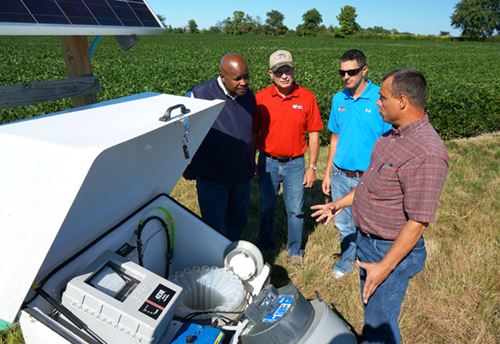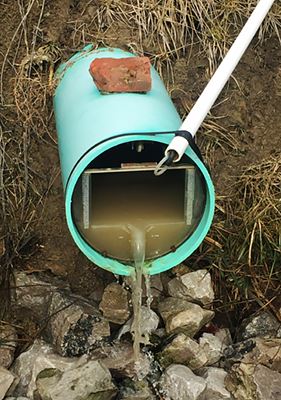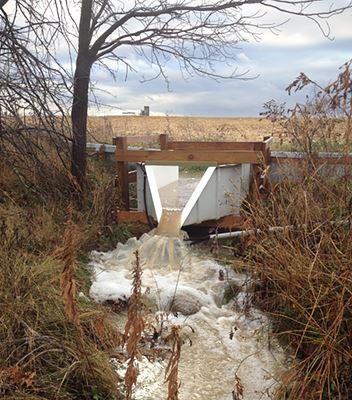Under the Microscope: What are the issues related to runoff from farms?
Kevin King: Runoff can occur when soil is saturated and no more water can be absorbed ("saturation excess"), or when the intensity of rainfall exceeds the infiltration capacity of the soil ("infiltration excess"). In addition, there is subsurface (tile) drainage. Many of the soils in the Upper Midwest are fine-textured and poorly drained.
To address these issues, many farmers have installed a system of pipes about three feet underground that removes excess water. In the poorly drained, humid regions of the U.S., this kind of artificial drainage is not an option, it is a necessity to grow crops.
When runoff or tile drainage (together known as "discharge") occurs on farm fields, it often carries with it pollutants such as the nitrogen and phosphorus found in agricultural fertilizers. Once in the water system, excess nitrogen and phosphorus create areas with low levels of oxygen ("hypoxia") and/or algal blooms. Some of these algal blooms may be toxic to fish, and may also necessitate significant, costly treatment to render the water in which they occur suitable for human consumption. The most notable hypoxic area in the U.S. is in the Gulf of Mexico, and it is, in part, a result of nitrogen from Midwestern farms. Harmful algal blooms in Lake Erie have also been linked to excess phosphorus from agricultural runoff.
UM: How can farmers reduce discharge and the associated agrichemicals?
King: There are several tools that can help minimize nutrient loss. One of the most popular tools is what we refer to as the "4Rs" of nutrient management: applying the "right source" of fertilizer, at the "right rate," at the "right time," in the "right place." The USDA-Natural Resources Conservation Service (USDA-NRCS) recently released something called the SMART initiative. SMART encompasses the 4Rs (Source, Method/Place, Rate, Time) and adds an "Assessment" component, which takes into consideration site-specific attributes.
Each practice included in the 4Rs/SMART can play an important role:
- "Source," the "S" in SMART, refers to the nutrient source. Organic fertilizers like manure have different characteristics than inorganic, synthetic fertilizers. Researchers are examining both to compare solubility (how easily they are dissolved in water), rates of nutrient loss, and more.
- Nutrient method or placement, the "M" in SMART, refers to how farmers apply fertilizer. Surface broadcast applications lead to greater nutrient losses than placement below the soil surface.
- “A" refers to assessment, and can include input from a certified nutrient management planner; evaluation of practices, such as cover crops, no-till, or conservation tillage; and soil testing.
- With respect to rate, the "R" in SMART, farmers can ensure they are applying fertilizer at the optimal rate through soil testing and adhering to existing recommendations.
- The time component, or "T", refers to both time since application and time of year. More time between fertilizer application and rainfall decreases nutrient loss. Applications closer in time to when crop plants need them have less nutrient loss, too.
UM: Are there challenges to farmers adopting recommended practices?
King: Absolutely. They include time and money, as well as farmers' perceptions about how effective the recommendations are. Most farmers are willing to consider many of the recommended practices. However, to overcome some of their doubts, farmers will need better information about costs and benefits, site-specific decision support tools, and technical assistance, including outreach and education workshops or field days with specialists who can address their questions.

Dr. Kevin King with NRCS Chief Terry Cosby and certified crop consultants Joe and Clint Nester describing the sampling equipment and approach for capturing edge-of-field and tile drainage discharge. Photo by NRCS
UM: How do changing climate conditions affect discharge, and how should we adjust?
King: Over the past couple of decades, there has been a significant increase in the number of larger, more intense rainfall events. That increased rainfall leads to increased surface runoff and keeps the fields wetter. These rainfall events are primarily in the spring, reducing the windows of opportunity for farming practices. This situation makes the need for tile drainage clear, to enable us to balance the impacts of crop production with our production needs. So, educating producers about the different options related to discharge and water quality is important.
In addition to wetter springs, we are also experiencing drier growing seasons during other times of the year. Climate projections suggest those drier growing seasons could get worse. So, we are interested in a full water management approach – that is, harvesting and storing excess water in the spring, and using it for irrigation later in the year.
UM: How does soil quality affect nutrient retention or loss, and what can farmers do about it?
King: Poor soil quality alters the natural flow paths of water, which short circuits natural soil "filtering," and can potentially negate any efforts associated with the SMART initiative. It can reduce infiltration, leading to increased surface runoff. There are a lot of initiatives underway to improve soil quality. Reducing tillage and planting cover crops are the first steps but may not be possible for every producer given the time and equipment requirements involved.

Tile drainage.
UM: What role does water management play in reducing nutrient loss? Are there any water management techniques that seem especially promising?
King: Water management is a broad concept that includes a number of practices designed to keep water where it is most useful and to minimize nutrient loss. These practices include controlled drainage, blind inlets, wetlands, cover crops, and drainage water recycling, among others. The effectiveness as well as the ability to implement these practices is site- and producer-dependent. Controlled drainage is the practice of artificially raising the elevation of tile drainage outlets, which promotes in-field water storage. Research has shown that it can significantly reduce the amount of water leaving a field, as well as nitrogen loss. Blind inlets disrupt surface flow to tile drainage and filter surface runoff. Wetlands also have potential to reduce some discharge and become nutrient sinks. However, they have a limited lifetime before transitioning from a nutrient sink to a source. Overall, though, wetlands do have environmental benefits and should be considered a water management, as well as water quality practice.
Another approach that is gaining traction is drainage water recycling, which involves capturing drainage water for later irrigation. Because it is a near-zero discharge system, it produces significant reductions in both nitrogen and phosphorus to downstream waters.
Finally, cover crops are an important tool that increases evapotranspiration, promotes infiltration and reduces nutrient loss, specifically nitrogen.
UM: What other approaches can help?
King: Other approaches might include edge-of-field structural practices, like phosphorus removal structures and denitrifying bioreactors or ditch design. Phosphorus removal structures are used to address surface runoff or subsurface drainage and are generally more effective when phosphorus concentrations are greater. Denitrification bioreactors target nitrogen losses. They are generally located at the edge-of-field near a drainage outlet and have been shown to be effective at removing nitrogen from tile drainage discharge. Drainage ditch design and management also has the potential to create nutrient sinks.

Flume with surface runoff from a USDA-ARS edge-of-field research site in northwest Ohio. Photo by Kathryn Rumora
Overall, nutrient transport is a basic side effect of food production. As researchers, we are always trying to find a balance between food production and environmental concerns, by identifying practices and approaches to minimize the negative side effects of agriculture. They will never be completely eliminated, because agricultural systems are 'leaky' in nature, but with the techniques and practices discussed here, we can seek to minimize the offsite transport of nutrients and agrichemicals.
You can learn more and hear Dr. King present his work here.